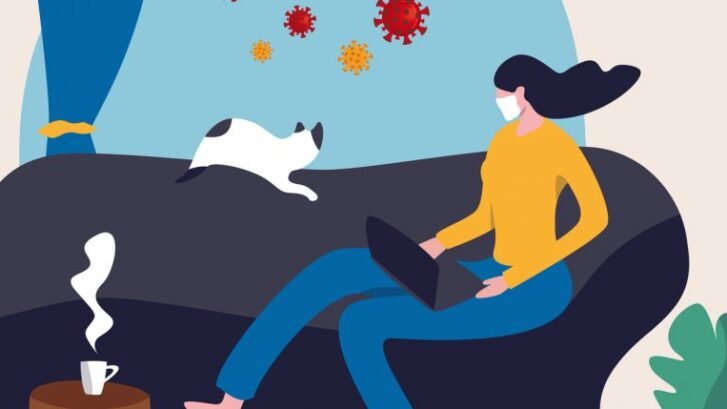Why Social Distancing is Crucial to Fight COVID-19
The longer we’re asked to practice social distancing, the more people—especially younger people—are chafing against the restrictions. Our concierge doctors at MD 2.0 would like to explore some of the many myths regarding social distancing and reiterate why this is the sole effective defense we currently have against this widening pandemic.
“It’s no worse than the flu, right?”
Yes and no. To date, the Centers for Disease Control and Prevention (CDC) estimates that 24,000 Americans have died from the current season’s flu, including 155 children. Keep in mind that this is for the entire flu season so far, which begins in the fall and lasts through April or May.
In the one month since the U.S. recorded its first COVID-19 death, nearly 3,000 Americans have died, with the rate soaring exponentially. This country’s coronavirus death toll tripled in a single week (last week).
The death rate for the two illnesses is also different, with deaths from the flu estimated at .1 percent of those who contract the virus, while even the best estimates for COVID-19 are 10 times that figure.
You may have heard COVID-19 referred to as the “novel” coronavirus. This means that because it is new to the population, no one on earth has any natural immunity to it, unlike with the flu or other coronaviruses such as the common cold.
“This is a new virus that has landed in the human community. We’re a brand new, naive population. We’re kind of siting ducks, right?” Ilhem Messaoudi, a virologist at the University of California at Irvine, told The Washington Post.
In addition, we have vaccines for the seasonal flu. An effective COVID-19 vaccine is a year to 18 months away.
Treatment is another difference between the two: For the flu, we have a number of effective antiviral medications that can reduce the length and severity of symptoms. Although a number of promising drug treatments for the coronavirus are being tested around the world, we still have no proven treatment.
Finally, because of its rapid spread throughout the vulnerable population, hospitals are being overwhelmed. The flu is a predictable seasonal virus, and our health care systems are set up to cope with it. The only effective treatment for those whose illness progresses to a severe level is the use of ventilators.
Because the virus kills by attacking the lungs and reducing oxygen availability, ventilators can not only force oxygen into the bloodstream through the lungs and remove carbon dioxide, they also provide a kind of “rest period” for the patient who is struggling to breathe on their own. With the normal flu-related pneumonia, patients typically need ventilation for four to five days; with COVID-19, severe cases require 15-20 days.
The U.S. is currently experiencing a severe shortage of ventilators. Many predict that, unless we can either increase ventilator supply or reduce patient load, doctors will be forced to choose who lives and who dies based on ventilator availability.
“But only old people get it”
Because the largest number of deaths have been among the elderly, younger people have somehow gotten the idea that they are immune, and that if they get it, it won’t be any worse than a mild flu. Hence, the coronavirus “parties” and spring breakers congregating on the beaches. But the evidence so far is proving them wrong:
- A 40-year-old nurse in New York City died from complications of the coronavirus.
- A healthy 39-year-old high school English teacher started with a mild fever and cough, ending up in a coma within 10 days.
- And just last week, an otherwise healthy 40-year-old was the first COVID-19 death recorded in Miami-Dade county.
- Finally, over the weekend, an infant in Chicago died after contracting COVID-19.
A CDC analysis of cases from February 12 to March 16 showed that 38 percent of those sick enough to be hospitalized were younger than 55. And last week the agency reported that 20 percent of those hospitalized were between 20 and 44 years old.
In France, half the coronavirus patients treated in intensive care units in Paris were younger than 65. The Netherlands reported the same ratio.
Deborah Birx, the White House coronavirus task force response coordinator, warned that “young people are getting seriously ill and very seriously ill in the ICUs.”
Why social distancing works
There are several fascinating video models available on the Internet showing why social distancing works, if you’d like to investigate. But the short answer is, right now the only way to stop this virus is to keep it from finding new hosts to invade.
Because it takes at least two days and up to 14 days from the time you are infected to when you begin feeling symptoms, every time you leave your home, you must assume you are infected and stay as far away as possible from other humans.
The Florida Department of Health provides an infographic guide to social distancing here https://s33330.pcdn.co/wp-content/uploads/2020/03/social_distancing.pdf.
Remember that, while panic is not productive, it’s only common sense to recognize the threat we all face and take appropriate measures to reduce it as much as possible.

